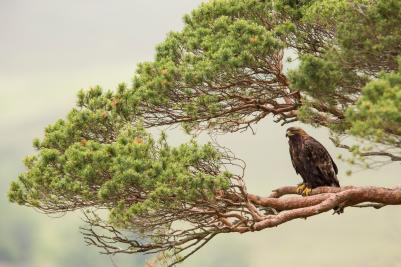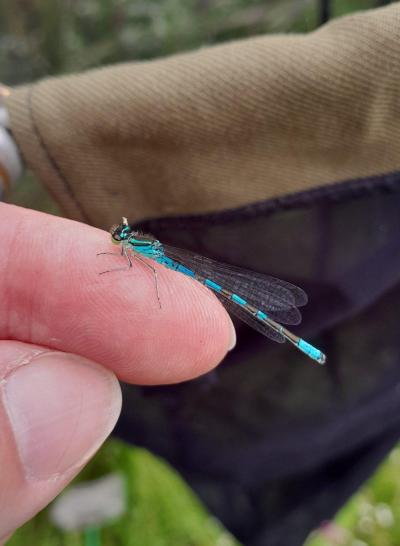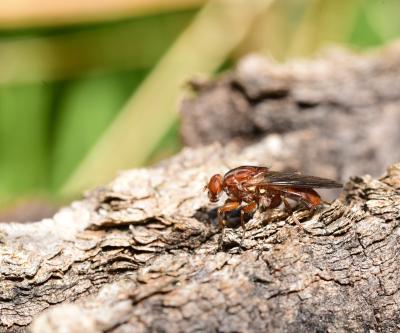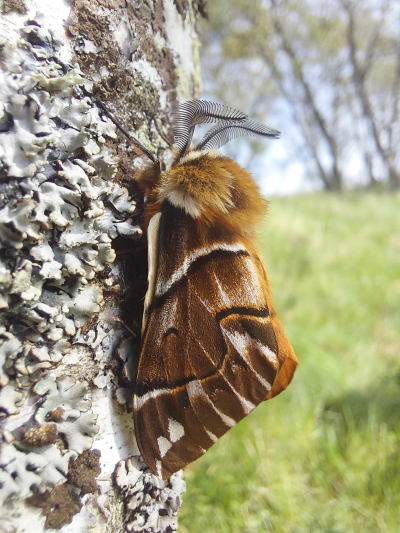Merlin
Falco columbarius

Accounts of the merlin date back to Medieval times, and this small raptor has migrated between Britain’s uplands and lowlands ever since. A ban on organochlorine pesticides has helped boost their numbers in recent decades.
Factsheet
Weight: 125 to 300g
Lifespan: Three years
Best time to spot: April to July
It may not be much bigger than a blackbird, but the merlin doesn’t let its small size hold it back. A ferocious hunter, it uses its knowledge of the land, speed and agility to tackle prey.
Merlins have a compact body between their pointed wings. Males are blue-grey with a dark bar at the tip of their tail and streaked, rusty underparts, while females are grey-brown. Both sexes have dark eyes and yellow legs, eye rings and beak bases.
The merlin’s wingspan ranges from 50 to 62cm. In flight, they follow the contours of the land, pumping their wings powerfully and rapidly with occasional short glides. They have been observed performing amazing aerial acrobatics while chasing prey, sometimes reaching speeds of 50km per hour.
In the Cairngorms National Park, their prey tends to be smaller birds that live in the montane, upland heath and blanket bog habitats the merlin frequents during the summer months. Meadow pipits, skylark, wheatear and chaffinch are caught in flight, though merlin will also regularly take moths and nestling birds.
Did you know?
Accounts of the merlin date back to Medieval times, and this small raptor has migrated between Britain’s uplands and lowlands ever since. A ban on organochlorine pesticides has helped boost their numbers in recent decades.
Factsheet
Weight: 125 to 300g
Lifespan: Three years
Best time to spot: April to July
It may not be much bigger than a blackbird, but the merlin doesn’t let its small size hold it back. A ferocious hunter, it uses its knowledge of the land, speed and agility to tackle prey.
Merlins have a compact body between their pointed wings. Males are blue-grey with a dark bar at the tip of their tail and streaked, rusty underparts, while females are grey-brown. Both sexes have dark eyes and yellow legs, eye rings and beak bases.
The merlin’s wingspan ranges from 50 to 62cm. In flight, they follow the contours of the land, pumping their wings powerfully and rapidly with occasional short glides. They have been observed performing amazing aerial acrobatics while chasing prey, sometimes reaching speeds of 50km per hour.
In the Cairngorms National Park, their prey tends to be smaller birds that live in the montane, upland heath and blanket bog habitats the merlin frequents during the summer months. Meadow pipits, skylark, wheatear and chaffinch are caught in flight, though merlin will also regularly take moths and nestling birds.
Did you know?
As an upland breeder, merlin come to the National Park in late March or April to mate and raise chicks. Over winter, they will head to lower elevations, either on the coast or farmland. Unlike some other raptors, they don’t always return to the same location to nest, and will often choose new partners each breeding season.
When nesting, merlins will most often create a bare scrape on the ground among deep heather, laying four or five eggs. Occasionally they will reuse a nest built by another bird. They are particularly fond of old crow nests built in small shelterbelts, isolated trees or on a woodland’s edge.
The female takes the lion’s share of the incubation responsibilities, which last for around a month. Meanwhile, the male hunts and provides defence.
The chicks fledge at 28 to 32 days, but a week or so beforehand, chicks will leave the nest and head into the surrounding vegetation. They continue to be fed by their parents for another month before flying off to start their solo lives. They will often choose a site close to their own place of birth when it’s their turn to breed.
Need to know
Merlin nest on the ground. To help prevent wildlife disturbance we ask that you:
- Pass wildlife slowly, steadily and cautiously when you do come across it.
- Don’t linger if an animal is disturbed by your presence.
- Use paths wherever possible to avoid trampling nests and prevent damage to vegetation.
- Take care if swimming or paddling near islands, as these are often a refuge for wildlife.
- Keep your dog in sight, if you are unsure if there are animals around it is safest to use a lead.
- Walk your dog on a lead, or at heel, during the breeding season where there are ground nesting birds.
- Learn to spot the signs of disturbance when watching wildlife, and be prepared to move on if you see these.
- Follow any local advice or signage about avoiding disturbance to wildlife.













